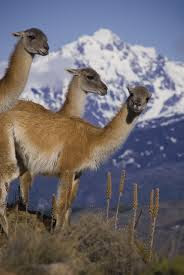SHARE THE TRAIL
The guanaco is a vulnerable animal native to the arid, mountainous regions of South America. They are found in the altiplano of Peru, Bolivia, Ecuador, Colombia, Chile, and Argentina. In Chile and Argentina, they are more numerous in Patagonian regions, as well as in places such as the Torres del Paine National Park, and Isla Grande de Tierra del Fuego. In these areas, they have more robust populations, since grazing competition from livestock is limited. A guanaco’s typical lifespan is 20 to 25 years.
Estimates, as of 2011, place their numbers at 400,000 to 600,000.
Guanacos live in herds composed of females, their young, and a dominant male. Bachelor males form separate herds. While female groups tend to remain small, often containing no more than 10 adults, bachelor herds may contain as many as 50 males. When they feel threatened, guanacos alert the herd to flee with a high-pitched, bleating call. The male usually runs behind the herd to defend them. They can run at 56 km (35 mi) per hour, often over steep and rocky terrain. They are also excellent swimmers.
Guanacos are one of the largest wild mammal species found in South America (along with the manatee, the tapir, and the jaguar). Natural predators include cougars, jaguars, and foxes. Guanacos often spit when threatened.
To protect its neck from harm, the guanaco has developed thicker skin on its neck, a trait still found in its domestic counterparts, the llama and alpaca, and its wild relative, the vicuña. Bolivians use the necks of these animals to make shoes, flattening and pounding the skin to be used for the soles. In Chile, hunting is allowed only in Tierra del Fuego, where the only population not classified as endangered in the country resides. Between 2007 and 2012, 13,200 guanacos were legally hunted in Tierra del Fuego.
Guanacos are often found at high altitudes, up to 13,000 feet above sea level, except in Patagonia, where the southerly latitude means ice covers the vegetation at these altitudes. For guanacos to survive in the low oxygen levels found at these high altitudes, their blood is rich in red blood cells. A teaspoon of guanaco blood contains about 68 billion red blood cells – four times that of a human.


No comments:
Post a Comment